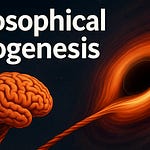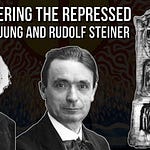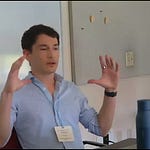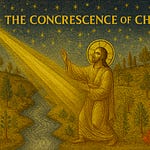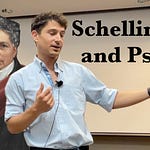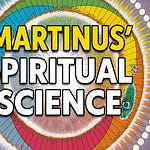Also in the mix: Daniel Smith's article "The Concept of the Simulacrum: Deleuze and the Overturning of Platonism"; James Bradley's article "Whitehead's Transcendental Cosmology: The Speculative Transformation of the Concept of Logical Construction"; Evan Thompson's book Mind in Life: Biology, Phenomenology, and the Sciences of Mind; and Tim's discussion with Michael Levin and Robert Prentner about Platonism in biology.
Tim and I (as usual) had a wide-ranging and complex discussion. There are a lot of ideas to untangle here, and there is never an easy place to begin. Indeed, in process metaphysics, all we can hope to do is begin again in media res. We orbit around the re-emergence Plato’s Ideas in biology. Tim and I are seeking to avoid the rigid Platonism of perfect immutable forms (originals) hovering above physical bodies (pale imitations or copies) and instead seek to invert or overturn Plato, offering a more processual approach that invites us to think beyond traditional hylomorphic schemes.
Mike Levin's work, and particularly this pre-print, presents a dramatic challenge to the reductionist paradigm, which attempts to explain biological form and agency in terms of collections of discrete material parts or biochemical laws, or in terms of more-or-less hand-wavy accounts of “emergence.” His pre-print is calling for a more layered or textured ontology: laws and patterns that operate not only on multiple scales, but even in realms that are not purely physical.
I’m grateful to both Tim and Mike for reaching out to philosophers in their attempt to grapple with these problems, which are both scientific and metaphysical in nature. In a time when many scientists—think of Neil deGrasse Tyson—dismiss philosophy as irrelevant, the collaborative spirit on display here feels like a hopeful new trend. Tyson and other prominent physicists perpetuate the cliché that philosophy of science is of no scientific use, that it is as irrelevant as ornithology is to birds. But Levin’s engagement proves otherwise.
20th century philosophers like Simondon, Whitehead, and Bergson sought to help scientists keep up with the metaphysical implications of their own scientific discoveries. Their efforts were aimed at reminding scientists that their own discoveries—evolution, quantum nonlocality, and spatiotemporal relativity, for instance—cannot be reconciled with mechanistic materialism. The mechanistic worldview inherited from Descartes, which dominated the scientific imagination for centuries, has been undermined by science itself.
That said, philosophers must continue evolving alongside science, integrating new findings into our speculative schemes without clinging to outdated assumptions. There is no final resting place in this journey. Reality is a perpetual flux (which is why I half-jokingly call it “Creality” in my book). The best we can do is to meet our ever-evolving reality with humility, continuously refining our conceptual schemes in sympathetic response with the rhythms of an environing cosmic community. It is a sobering but liberating task. There is no point of arrival in philosophy or science, only a creative advance into deeper understanding (Inshallah!).
Within this larger project, I believe it is crucial to distinguish between cosmology and metaphysics. Whitehead’s insights on this distinction are essential here. Cosmology concerns the empirical study of contingent phenomena—patterns and regularities that emerge within our particular cosmic epoch. These patterns are historical and subject to change, to evolution. In contrast, metaphysics seeks the principles that condition the possibility of any cosmic epoch. These are not empirical findings but regulative ideals, philosophical principles or categorical conditions. We should not presume to have definitively grasped these categories, for they remain forever subject to revision in light of new experience.
If we understand Mike’s work to be operating within the domain of cosmology, then I am largely in agreement with him. He posits the existence of what we might call transphysical agencies, non-physical yet organizing forces akin to Plato’s animating deities. For the ancient Greeks, stars and planets were not dead material bodies; they were living beings with their own intelligence and agency. Today, we might call them complex self-organizing systems, but the underlying intuition remains: there is something living or at least life- and mind-like about the cosmos at all levels. Thus, I affirm Mike’s generally panpsychist orientation when it comes to cosmology.
However, my reservation arise if we shift to considering Mike’s proposal at the metaphysical level. He attributes agency to the Platonic forms or possibilities themselves, suggesting that they possess a kind of active intelligence that presses into the actual world. Here I diverge, leaning instead on Whitehead’s view. In Whitehead’s metaphysics, agency belongs not to eternal objects but to actual occasions—events that prehend possibilities and creatively actualize them. Forms do not impose themselves from without; they are taken up and transformed by occasions in the ongoing process of becoming. This distinction may appear subtle, but I see it as crucial. If we imagine forms as autonomous agents, we risk reducing potentiality to actuality by canceling any real distinction between them. Whitehead avoids this over-simplification by way of a dipolar ontology, in which eternalities and actualities exist in a relationship of mutual conditioning, mediated by a divine actuality.
This is where Whitehead’s notions of the primordial and consequent nature of God come into play. The primordial nature conceptually prehends the infinite realm of eternal objects and can be said to shepherd all pure possibilities—forms that are not yet actualized in spacetime—into a unified (maximally simple) organizational continuum. The primordial nature carries the scent of both Heraclitus’ Logos and Plato’s Eros. The consequent nature, on the other hand, gathers together the creative achievements of actual occasions and the ideal possibilities refracting from them, weaving the dipole into a coherent whole. The consequent nature is like a cosmic memory, a tragic poet compelled to reconcile the wretched wreckage of history with the ideal judgment of the cosmic aesthete. Despite its macrocosmic significance, the divine dipolarity of primordial mental pole and consequent physical pole is just another instance (the first though still entirely accidental example) of Concrescence, and like all currently concrescing (in “unison of becoming” with one another) finite microcosmic spatiotemporal occasions of experience, God lives, dies, and is reborn eternally in and through the ever-ramifying and creative NOW. In this way, eternal forms are never free-floating substantially existing essences; they are dynamically entangled here and now and everywhere with actuality (ie, entangled with both the divine actual entity and all other actual occasions).
Mike’s notion of “pointers” represents an important attempt to articulate how biological (and possibly future AI) systems interact with what might be called latent space—a domain of potential forms that have not yet been actualized. I would suggest that these pointers are not merely passive conduits; they engage in a dynamic process of selection and transformation, drawing out and enabling certain potentials to ingress into actuality. Mike explicitly borrows the term ingression from Whitehead, who used it to describe how eternal objects—possibilities or patterns—are synthesized into concrete actual occasions and the historical routes or societies they form (all enduring physical bodies are “societies” in Whitehead’s terms).
Both Tim and I diverge from approaches that treat latent space (ie, the realm of eternal objects) as fully predetermined. We cannot assume that latent potentials simply exist as brute facts, waiting to be revealed or discovered. Rather, the process of actualization is itself relational, shaped by the creative tensions between past inheritances and the relevant novelty brought forth as historically situated actual occasions dip into eternal possibility from their unique perspectives. The relationship between actual and potential is one of ongoing negotiation and mutual transformation.
Mathematics provides a powerful analogy here. It is tempting to think of mathematical truths as eternal and unchanging, existing independently of human discovery. Yet history shows that mathematics evolves through a complex interplay of discovery and creation. When Whitehead and Russell attempted to construct a complete formal foundation for mathematics in Principia Mathematica, they encountered paradoxes that required significant revisions. Russell introduced the doctrine of types to avoid paradoxes in some logical statements. However, as Ronny Desmet has described it, this solution was insufficient, leading to a more complex “ramified” theory of types, which itself proved too restrictive. To address these issues, Russell added further measures like the “axiom of reducibility,” the “axiom of infinity,” and the “multiplicative axiom.” This extensive patchwork undermined his goal of logically reconstructing mathematics from the bottom-up, from basic principles, forcing he and Whitehead instead into a more inductive, top-down approach to mathematical research.
The mathematical imagination is an example of what Whitehead referred to as conceptual prehension in action. Actual occasions of experience, including those composing mathematicians’ streams of consciousness, do not simply uncover pre-existing or pre-individuated terms; they engage with a tensive field of potential patterns that is conditioned by both the subjective aim of their mental pole and the social environment inherited in their physical pole. There is also a divine “lure” or initial aim that orients this engagement, guiding which potentials become salient. I think Mike’s pointers can function in a similar way—they are systems that interact with latent space, selecting and actualizing certain possibilities based on their interface with the environment. The process is neither purely one of discovery nor pure invention; it is an emergent relationship that transcends that dichotomy.
This entangled interplay between discovery and invention highlights the participatory nature of both cognition and morphogenesis. In morphogenesis, forms are not imposed from without (whether by genetic information or pre-determined Platonic Ideas) but arise through the complex causality of self-organizing activity (with various causalities at play, including material, efficient, formal, and final). Similarly, in cognition and perception, we do not passively receive information from the world. This is not a one-way imposition of order but a reciprocal exchange between the actual and the virtual.
This feedback loop echoes Whitehead’s understanding of Creativity: a transcendent-immanent principle that sustains the dipolarity between potential and actualization. Creativity is a close analog of what Deleuze describes as "difference in itself"—a field of pure difference that generates new actualities without relying on static templates.
Some words of caution: If this latent space is treated as a pre-existing reservoir of fully determinate possibilities, we risk falling into a form of actualism (defined by physicist Tim Eastman). Actualism transposes brute facts from the domain of the actual to the domain of the virtual, thereby canceling the difference and eliminating the polarity. Without this dipolarity, the dynamo of cosmogenesis would lose its dynamic charge. There is no purely autonomous, determining realm of forms; rather, potentialities are continually reconfigured within the larger process of evolutionary becoming. This is why the concept of a divine lure or initial aim is central to Whitehead’s philosophy. It provides a minimal structure of relevance—a pre-tuning of indeterminate tensions in the web of potentials, if you will—that guides the emergence of new actualities without determining them outright.
This brings us to the broader philosophical problem of transcendence and immanence. Whitehead’s Creativity functions as a transcendent-immanent principle: everything actual exemplifies it, and yet in and of itself it is never fully graspable. Without some guiding aim—what Whitehead calls the divine lure—there is a risk of losing ourselves in endless difference: simulacra all the way down. For Whitehead, this divine aim does not dictate but persuades, offering a horizon of relevance that shapes each occasion’s becoming.
This ethical dimension is vital. Philosophy, especially process philosophy, is not about asserting final answers. It is about participating in the creative advance of life, remaining open to new insights while critically interrogating the concepts that guide us. Transcendentals like Truth, Beauty, and Goodness serve as regulative ideals—not fixed absolutes but lures toward deeper realization. Even when we encounter aporia, when our concepts fail, we are called to lean into that uncertainty, to live without the comfort of final explanations.
Ultimately, this is the task of speculative philosophy: to articulate the conditions, tensions, and transformations that structure our world, knowing that this work is never finished. We are embedded in a vast cosmic history, yet always called to creatively transform it in the present. Philosophy’s task is to help us navigate this process, not by positing grand explanatory systems but by attuning our thinking the evolving rhythms of cosmic life.
Video of our dialogue:





